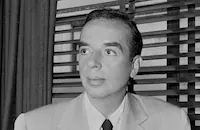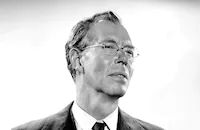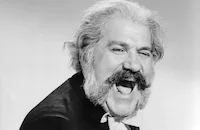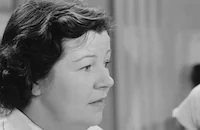The Long, Long Trailer

Brief Synopsis
Cast & Crew
Vincente Minnelli
Lucille Ball
Desi Arnaz
Marjorie Main
Keenan Wynn
Gladys Hurlbut
Film Details
Technical Specs

Synopsis
On a rainy night, Nicholas Carlos Collini arrives at the Laramie Trailer Park in Colorado and pounds on the door of his trailer before noticing the "for sale" sign. In the park manager's office, Nick meets Mr. Tewitt, who is thinking of buying a trailer. Nick urges Tewitt to avoid such a purchase for the sake of his marriage, adding that he has been searching for his own wife for the past three days. Nick describes how the trailer came to blight his life: Two months earlier, in Los Angeles, Nick laughs uproariously when his fiancée Tacy proposes buying a trailer, but she tearfully insists that a trailer would be the only way for them to have their own home while Nick travels on business. Tacy shows Nick a brochure for the fully furnished "Bungalette" model and says a honeymoon in a trailer would be very romantic. They attend a trailer show and look at the Bungalette, which turns out to be disappointingly small. Tacy is then dazzled by an enormous, very expensive trailer and persuades Nick to buy it. The salesman recommends that they have the trailer professionally moved to Colorado, where a job awaits Nick, but Tacy insists that pulling it themselves would be much more fun. Nick buys a new car and has it modified for hauling a trailer, and the mechanic gives the inexperienced Nick a quick lesson in driving with a trailer. Nick and Tacy get married and leave on their honeymoon, although Nick finds driving with the forty-foot, three-ton trailer nerve-wracking. Eventually they arrive at the Breeze Bay Trailer Park, but as Nick attempts to carry Tacy over the threshold of their trailer, they are beset by meddling neighbors who think that Tacy has injured her ankle. Late that night, the neighbors finally leave, and the overbearing Mrs. Hittaway tells Nick she has given his wife a sleeping pill. The following morning, Tacy convinces Nick to leave the noisy trailer park and set up camp in the woods, but the trailer gets stuck on the enbankment of a deserted logging road and has to be towed out. The newlyweds then head off to visit Tacy's aunt Anastacia, and Tacy's huge family is waiting to greet them and have a look at the trailer. After bragging about his driving skills, Nick destroys most of the front yard while trying to back the trailer into the driveway, and the couple depart the next day after returning the check Anastacia gave them for their wedding to cover the damages. Nick and Tacy return to the open highway, and soon come to enjoy domestic life in their trailer. One day, Tacy insists on doing the driving, which leads to the couple's first big fight. They later make up, and Tacy proposes that she simplify their life by starting to prepare their dinner before they stop for the night. However, Tacy's first attempt to cook an elaborate meal in the trailer while Nick is driving is a messy disaster. The following day, Nick tells Tacy he has received a cash offer for the trailer, but she refuses to consider selling it. As they approach their final destination in Colorado, Nick tells Tacy they must lighten their load before tackling the 8,000-foot ascent. Tacy is loathe to part with the collection of heavy rocks they have acquired as souvenirs during their travels, and without telling Nick, decides instead to distribute them evenly throughout the trailer. The Collinis nervously begin the hair-raising ride up the steep, narrow mountain road. After barely surviving their perilous trip, Nick discovers the rocks in the trailer and begins hurling them over the side of the mountain, despite Tacy's screams of protest. Back in the rainy trailer park, Nick tells Tewitt that after he and Tacy drove down the mountain without speaking, he unhooked the car and drove away. Tewitt encourages him to apologize, but Nick stubbornly blames Tacy for everything. When Tacy returns to the park, Nick goes to see her, but she greets him coolly. He starts to drive away, but Tacy runs after him, and the couple blurt out their apologies before returning to their trailer.

Director

Vincente Minnelli
Cast

Lucille Ball

Desi Arnaz

Marjorie Main

Keenan Wynn

Gladys Hurlbut

Moroni Olsen
Bert Freed
Madge Blake

Walter Baldwin
Oliver Blake
Perry Sheehan

Charles Herbert
Karl Lukas
Louis A. Nicoletti
Howard Mcnear
Charles Victor
Herb Vigran
Bert Moorhouse

Jack Kruschen
John Logan
Geraldine Carr
Sarah Spencer
Dallas Boyd
Edgar Dearing

Emmett Vogan
Ruth Warren
Edna Skinner
Alan Lee
Robert Anderson
Phil Rich
John Call
Wilson Wood
Dorothy Neumann
Howard Wright
Connie Van
Dennis Ross
Christopher Olsen
Ida Moore
Richard Larson
Emory Parnell
Fay Roope

Peter Leeds
Juney Ellis
Ruth Lee
Frank Gerstle
Dick Alexander
A. Cameron Grant
Rudy Lee
Stevi Rodin

Margaret Bert
Rollin Moriyama
Robert Kiuo
Jimmy Ames
Judy Sackett
Janet Sackett
Norman Leavitt
Crew
Pandro S. Berman
Adolph Deutsch
Alvord Eiseman
Cedric Gibbons
A. Arnold Gillespie
Haven Gillespie
Keogh Gleason
Frances Goodrich
Sydney Guilaroff
Albert Hackett
Warren Newcombe
Helen Rose
William Ryan
Douglas Shearer
Seymour Simons
Michael Steinore
Robert Surtees
Jerry Thorpe
William Tuttle
Ferris Webster
Richard A. Whiting
Edwin B. Willis

Videos
Movie Clip



Trailer
Hosted Intro




Film Details
Technical Specs

Articles
The Long, Long Trailer
Just a few years earlier, Ball had been a contract player at MGM. Although she'd had some starring roles, she was usually cast as the wisecracking pal of the leading lady, or the foil for such actors as Red Skelton. Arnaz, who had met Ball when both appeared in RKO's Too Many Girls (1940), had an even spottier movie career - there weren't many roles for Cuban conga players. It wasn't until they turned to television in 1951 that the couple became superstars on the small screen.
Meanwhile, back at MGM, the same team that had made Father of the Bride (1950), and its sequel, Father's Little Dividend (1951) - producer Pandro Berman, director Vincente Minnelli, and screenwriters Frances Goodrich and Albert Hackett - had another domestic comedy in the works. The Long, Long Trailer (1954) was based on a non-fiction book about a middle-aged couple who spent a year traveling cross-country in a mobile home. By making them honeymooners, and making the husband Latin and the wife wacky, the script was perfect for the king and queen of television. (Arnaz, in fact, had tried to buy the rights to the book, but Berman had beaten him to it.) But MGM executives wanted no part of it. At that time, studios were trying desperately to lure audiences away from the television and into theaters. And they were convinced that people wouldn't pay to see actors they could get at home for free. But since The Long, Long Trailer would be an inexpensive film to make, the studio finally agreed.
Ball was coy at first, telling interviewers she didn't care if she ever made another movie, but adding that she might make one during the summer hiatus, "just to see how I look in Technicolor. You know, I've been in gray and black for a long time now." But her lack of stardom in films must have rankled, and returning to MGM in triumph was sweet revenge. The Long, Long Trailer was shot in six weeks during the summer of 1953, and in spite of the complexity of some of the sequences, Minnelli recalled it as one of the easiest films he ever made.
Critics may have grumbled that "Tacy" and "Nicky" were just Lucy and Ricky on wheels, but they had to admit that nobody was better at slapstick farce than Ball, and nobody played exasperated hubby better than Arnaz. Millions of I Love Lucy fans agreed - they made The Long, Long Trailer one of 1954's biggest hits. The couple was as big at the box office as they were in the Nielsen ratings. And the film has retained a cult following to this day thanks to such hilarious scenes as Lucy trying to make dinner in the trailer's kitchenette while Desi maneuvers a hazardous road or the sequence where Lucy's obsessive rock collecting pushes Desi over the edge - literally.
Producer: Pandro S. Berman
Director: Vincente Minnelli
Screenplay: Albert Hackett and Frances Goodrich, based on the novel by Clinton Twiss
Editor: Ferris Webster
Cinematography: Robert Surtees
Art Direction: Cedric Gibbons, Edward Carfagno
Music: Adolph Deutsch
Cast: Lucille Ball (Tacy Collini), Desi Arnaz (Nicholas Carlos Collini), Marjorie Main (Mrs. Hittaway), Keenan Wynn (Policeman), Gladys Hurlbut (Mrs. Bolton), Moroni Olsen (Mr. Tewitt), Bert Freed (Foreman), Madge Blake (Aunt Anastacia).
C-96m. Closed captioning.
by Margarita Landazuri

The Long, Long Trailer
TCM Remembers - Jack Kruschen
Jack Kruschen (1922-2002)
He may have not been a household name, yet his career consisted of over seventy-five films, spanned over six decades, and displayed a strong versatility in playing either dramatic or comic roles with equal effectiveness. He was the definitive, "I can't quite remember the name, but I remember the face" character player who enlivened many films with his robust frame, cherubic face and infectious smile. His name was Jack Kruschen, a superb performer who died on April 2, 2002 at the age of 80, leaving behind a strong body of work that was impressive as any character actor of his generation.
Kruschen was born on March 20, 1922 in Winnipeg, Manitoba, Canada. The son of a watchmaker who later set up shop in Hollywood, he was performing in an operetta at Hollywood high school when a talent scout for CBS radio discovered him. Kruschen was soon doing voice characterizations on popular network programs such as Dragnet, The Danny Thomas Show and Sam Spade. With his gift for dialects (he was most adept at playing ethnic types like Greeks, Yiddish or Italians - a skill finely honed in his radio days), Kruschen was a natural for the movies and soon made his film debut with a small role in the Betty Hutton comedy Red, Hot and Blue (1949).
Kruschen's early career is peppered with a variety of roles like a comical gangster in both Abbott & Costello Go to Mars (1953) and Money from Home (1953) starring Jerry Lewis & Dean Martin; a hard-nosed police detective in Confidence Girl (1952) and Julie (1956), an underrated Doris Day thriller; or doomed victims to alien prey in Sci-fi cult classics: the 1953 version of War of the Worlds (fans remember him as Salvatore, one of the first earthlings to be killed by the invading Martians) and The Angry Red Planet (1959). The roles offered steady work, but not much critical recognition. All that changed when Billy Wilder cast him in the key role as Jack Lemmon's bemused but caring neighbor, Dr. Dreyfuss in The Apartment (1960). As the man who observes the steady stream of women in and out of Lemmon's apartment and the one who saves Shirley MacLaine from a drug overdose, Kruschen offered a wonderful performance - viewing his neighbor's proceedings with a jaundiced eye, yet never letting his disdain overtake his humor and humanity. He was justly rewarded with an Oscar nomination as Best Supporting Actor.
From this point on, Kruschen was seldom out of work, appearing in over 40 films (including a terrific dramatic turn in the original Cape Fear (1962) as Dave Grafton, a corrupt southern bigot) and nearly 60 guest roles on television for the next two decades. Kruschen would later find fame toward the end of his career when he was cast as Papa Papadapolis in the hit sitcom Webster (1985-1987) and would show pleasant variations of the "kindly old codger" throughout the remainder of his career - like his final role in the romantic comedy 'Til There Was You (1997). His death in April this year may have gone largely unnoticed by the movie-going public, but for those of us who treasure the art of the character player, Kruschen's passing was a loss that is fortunately compensated by his strong body of work that will be enjoyed for fans of the late show for many years to come.
By Michael T. Toole
SIGNE HASSO, 1910-2002
Actress Signe Hasso died June 7th at the age of 91. She was best-known for starring in A Double Life (1947) but played numerous Europeans in films during the 1940s. Hasso was born on August 15, 1910 in Stockholm, Sweden and began acting on stage at the age of 13. Ten years later made her first film appearance as Signe Larsson. She was married in 1936 and adopted the last name of her husband, cinematographer and later director Harry Hasso. After a dozen Swedish films, Hasso moved to Hollywood in 1940 where her first screen appearance was an uncredited role in Journey for Margaret (1942). A brief stint at RKO didn't lead to any more promising film parts so Hasso concentrated on her stage career in New York City. Eventually, her film career became more active, thanks to a quick succession of roles, most notably in Fred Zinnemann's The Seventh Cross (1944), Douglas Sirk's A Scandal in Paris (1946) and Henry Hathaway's The House on 92nd Street (1945). However it was her portrayal of Ronald Colman's wife in the Oscar-favorite A Double Life that solidified her fame. But as Hasso continued to act on the stage and TV, her film work began to taper off. She appeared in high-profile thrillers like Crisis (1950), several made-for-TV movies, a few European productions and even the cult murder mystery, Bert Gordon's Picture Mommy Dead (1966). In 1972, the king of Sweden decorated Hasso for her work. Her final appearance was in a 2001 documentary about Greta Garbo.
HERMAN COHEN, 1927-2002
One of the key producers of B-movies, Herman Cohen, died June 2nd at the age of 76. Like most producers, his name wasn't generally known outside the industry or the realms of film buffs but most people never forget the titles of his films: I Was a Teenage Werewolf (1957), Horrors of the Black Museum (1959) and the not-quite-immortal Bela Lugosi Meets a Brooklyn Gorilla (1952). Cohen was a Detroit native, born August 27, 1927. He entered the film business in the smallest possible way, as a 12-year-old janitor, often accepting passes for his family and friends instead of wages. Cohen served in the Marine Corps (several articles incorrectly say the Army) before becoming a publicist at Columbia Pictures. By 1951 he was working as a producer's assistant on low-budget independent films, mostly for Realart Pictures run by another Detroit native Jack Broder. Soon Cohen was producing his own movies, including Westerns and mysteries, until hitting big with the famous I Was a Teenage Werewolf. Starring a then-unknown Michael Landon (under personal contract to Cohen who later tore it up so Landon could appear in Bonanza), the film was made for $100,000 but in just a few months grossed over $2 million. Cohen didn't hestitate to turn out I Was a Teenage Frankenstein and Blood of Dracula by Thanksgiving of that same year and before long had made several films that continued to earn money for years to come. (One TCM writer remembers Horrors of the Black Museum turning up in a small Alabama town in the early 70s, over a decade after its initial release. The film is scheduled for a DVD release with a Cohen commentary from VCI Entertainment.) Cohen also made several films in England including The Headless Ghost (1959) and the cult favorite Konga (1961) where Cohen even paid RKO $25,000 for the rights to use the title King Kong in publicity for his own film. Cohen's later movies included a spaghetti Western and Joan Crawford's final acting role Trog (1970). In the 1980s Cohen ran a company, Cobra Media, that distributed some films and licensed material such as Teenage Werewolf to Landon for use in one of his Highway to Heaven episodes.
By Lang Thompson
TCM Remembers - Jack Kruschen
Quotes
It's a fine thing when you come home to your home and your home is gone!- Nicholas Collini
What happened?- Tacy
Oh nothing, I just cracked my skull.- Nicholas Collini
Trailer brakes first!- Mechanic
Get that check back. I was going to get us a deepfreeze.- Tacy
You're getting a deepfreeze right now.- Nicholas Collini
This is Mrs. Dudley, the big vagabond next door.- Mrs. Hittaway
How do you do, Mrs. Vagabond?- Tacy
Trivia
In the film, Desi and Lucy buy a new 1953 Mercury to pull the long, long trailer, but during the hill-climbing scene it is the larger '53 Lincoln doing the pulling of the trailer up the steep grades. In one shot rounding a curve, the distinctly different grill of the Lincoln can be seen clearly.
In the original cut of the film, the "Breezin' Along with Breeze" musical number had an entirely different backing track orchestration. However, Minnelli did not approve of the final cut, and removed the music from the sequence, leaving only the original vocal overdubs, in which he then ordered an entirely new orchestral number, and mixed the vocals within the scene. The original recording, however, was thought to be lost forever, until recently resurrected from the MGM vaults and compiled onto a love songs CD by Rhino Music.
Notes
According to a modern source, Desi Arnaz sought the film rights to the novel The Long, Long Trailer in May 1952, but was outbid by M-G-M. A January 22, 1953 item in Hollywood Reporter's "Rambling Reporter" column reported that M-G-M was talking with William Holden about a role in the film. Portions of the film were shot on location in Yosemite National Park, CA. The end credits include a statement thanking the Department of the Interior, National Park Service, for permission to photograph scenes there.
At the time The Long, Long Trailer was made, the husband-and-wife team of Lucille Ball and Arnaz were the producers and stars of the country's most popular television comedy, I Love Lucy (CBS, 1951-57). In his memoir, director Vincente Minnelli quoted producer Pandro S. Berman as saying that the studio initially was unenthusiastic about signing the famous couple: "[M-G-M] subscribed to the theory that the audience wouldn't pay to see actors they could get at home for free. But I insisted these were different parts, and Lucille Ball and Desi Arnaz could make the picture hilarious." According to February 1954 news items, the couple received a $250,000 fee for appearing in the film.
A modern biography of Ball stated that Arnaz and his production executive, Martin Leeds, bet Loews executive Benjamin Thau $50,000 that The Long, Long Trailer would outgross M-G-M's 1950 hit Father of the Bride (see AFI Catalog of Feature Films, 1941-50). According to the biography, Arnaz won the bet, and he and Ball ended up with a total salary of $300,000. Although some news items reported that this film would mark Ball and Arnaz's first screen appearance together, they both had appeared in the 1940 RKO film Too Many Girls (see AFI Catalog of Feature Films, 1931-40). Ball and Arnaz made one additional film together in 1956, M-G-M's Forever, Darling (see entry above). The couple married in 1940 and divorced in 1960.
According to the Saturday Review (of Literature) review, M-G-M entered into cross-promotional arrangements with several of the manufacturers whose products were featured in the film, including the New Moon Trailer Company, the Mercury car company and Youngstown, which made kitchens for mobile homes. A July 16, 1953 "Rambling Reporter" column in Hollywood Reporter claimed that Ball and Arnaz requested that the film prominently display a package of Philip Morris cigarettes-their television sponsor-and chidingly referred to their production company, Desilu, as "Desiloot Productions."

Miscellaneous Notes
Released in United States February 17, 1991
Released in United States Winter February 1954
Shown at Pacific Film Archive (Idependent Group: The Aesthetics of Plenty) in Berkeley, CA February 17, 1991.
Released in United States Winter February 1954
Released in United States February 17, 1991 (Shown at Pacific Film Archive (Idependent Group: The Aesthetics of Plenty) in Berkeley, CA February 17, 1991.)














